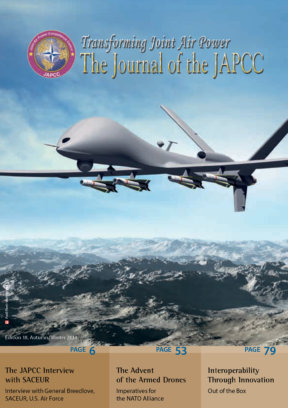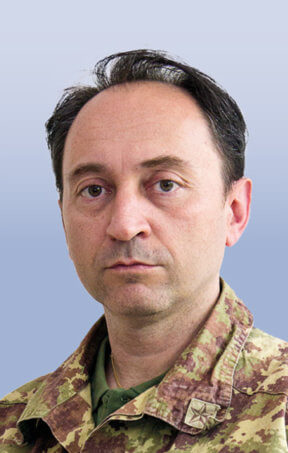Two Problems
Current military operations have shown that medical support is a fundamental capability for an expeditionary military force. This operational requirement has been emphasised in theatres such as Afghanistan, where local medical facilities have been completely depleted by war, rendering host nation medical support less than adequate according to Western standards. In addition, the Afghan tactical situation consists of several bases and Combat Outposts (COP) scattered all across the Country, making mutual support extremely difficult. Improvised Explosive Devices (IEDs) and Small Arms Fire (SAF) attacks strike military convoys far away from the Main Operating Base (MOB) leaving the casualties in mortal danger if not quickly rescued by medical personnel. In the Afghan Operational Theatre, the rescue in the forward zone usually benefits of helicopters in order to respect the golden hour policy1. In accordance with NATO STANAG 32042, Forward MEDEVAC3 is “the phase of evacuation which provides airlift for patients between points within the battlefield, from the battlefield, as far forward as the point of wounding, to the initial point of treatment and to subsequent points of treatment within the combat zone”. This means highly skilled medical crews rely on helicopters for a rapid ingress directly to the wounded, regardless of their proximity to enemy positions. But not all services are able to deploy these kinds of highly skilled medical personnel and, often, the medic, doctor or nurse on board has only basic trauma skills, which are not enough to treat the severe traumas IED / SAF victims suffer.
Consequently, the two main issues found in Afghanistan are in assisting patients in-flight and being ready to rescue personnel inside the combat zone.
In 2010, to solve this problem, the Italian Army decided to begin a Forward MEDEVAC implementation programme in order to conduct critical care rescues. Meanwhile, new tactics have been developed by the deployed Aviation Battalion to relieve units in distress or under fire. However, because this tactics update is only applied by the Army Aviation, it’s now necessary for the wider application of Forward MEDEVAC as part of a joint approach together with Medical Services and the Air Force as well.
Together with medical and technical issues, there are also organisational and interoperability issues. Due to the multinational nature of today’s contingencies, MEDEVAC supports more than one nation’s Army, Navy or Air Force branch and must closely coordinate the efforts of the involved medical corps, ground units and flight crews.
Army Initiatives
To minimise losses, medical support to military operations is composed of two components. The first relies on the first responders or Combat Life Savers (CLS), who are part of the infantry and are specially trained for buddy-aid and first aid; while the second is based on medical professionals belonging to the Medical Corps. Enhancing the soldier’s basic skills in buddy care and permitting them to call in a MEDEVAC via a correct 9-line report was the first step in improving the chain of events.
Following this improvement, in early 2010, Italian Army Aviation (ITAAVN), together with the Medical Corps, developed an implementation programme to update MEDEVAC helicopters. The nature of the Afghan scenario and the diffusion of airmobile / air assault operations required an improvement in almost every factor of the DOTMLPFI4 process.
Realising that the Medical Corps wasn’t able to address the complex problems alone, a Working Group was formed consisting of pilots, flight engineers and medical officers. At the completion of the project, some important guidelines were established as a foundation for the new Forward MEDEVAC Team (FMT)5, a unit with a strong combat mission orientation and enhanced medical capabilities. The guidelines are focused on personnel selection, flight training for medical crews, equipment and aircraft interoperability.
Aircraft and MEDEVAC Equipment
Excluding the US Armed Forces, it’s almost impossible for other NATO nations to put in service standing flight units with helicopters exclusively equipped for MEDEVAC service, with electro-medical devices and medical crews. In every other case without the US engagement we find a build-up of Task Forces with dedicated helicopters that, for a specific operation, are diverted to the MEDEVAC role.
This is what occurs in Italian Army Aviation; consequently, easy reconfigurable medical equipment was required in order to equip all the aircraft currently in service. At the moment, ITAAVN operates the UH-1 family, CH-47C (soon F) and NH-90 in utility and cargo duties in which the medical equipment has to fit.
The medical equipment comprises everything needed for in-flight stabilisation, resuscitation and intensive care and fits into the Patient Transport and Support (PTS) system. The PTS stretcher is a modular system that allows quick setting of the desired combination of electro-medical devices. The system lists all the state-of-the-art devices. The STARMED Company delivered the equipment with a Joint Aviation Requirement certificate for in flight movement using the NATO stretcher bearer. In addition, Army Aviation conducted a series of flight tests in order to use all the devices, to include the defibrillator in flight.
Personnel Selection and Training
Personnel forming MEDEVAC crews are doctors and nurses mainly belonging to Rome’s Military Hospital intensive care unit and having consolidated experience in pre-hospital, intensive care. The crews are reinforced with Army Aviation medical personnel employed in the airfields as emergency teams; these people have confidence with rotary wing assets but lack pre-hospital care skills. To improve their capability in this matter, the Army created several agreements with local civilian hospitals allowing the use of military personnel on board civilian ambulance and Helicopter Emergency Medical Service (HEMS) aircraft.
To allow medical personnel to operate on-board military aircraft as aircrew, specific procedures have been applied consisting of an in-flight physical examination, a two week course, pre-deployment training and evaluation exercises.
The Army Aviation MEDEVAC course focuses on aircrew skills in order to ensure the successful achievement of both aircrew and medical duties side by side with flight engineers and door gunners. An aim of the course is to not be a ‘burden’ on normal flight operations. In addition, the medical crew should be able to operate when emergency procedures are conducted and after an emergency landing. Finally, MEDEVAC personnel must be familiar with the specific electro-medical devices and the rescue equipment on Army helicopters.
A specific part of the training focuses on the so called ‘non-technical skills’ regarding both flight safety and medical procedures, since the pilots, Physicians and Nurses are required to operate in according to the principles of Crisis Resources Management, to reduce the Human Factor errors and maximise communication and safety.
Due to the hostile nature of the rescue areas, all the medical personnel have qualified Survival, Escape / Evasion, Resistance and Extraction (SERE)6; meaning they are able to use survival equipment, to perform tactical ground navigation, to use infantry weapons and to be rescued by Combat Search and Rescue (CSAR) assets. Before being sent overseas, the medical crews are grouped with the mounting flight unit in order to bring together airmen and doctors for a final cycle of exercises, concluding with the Aviation Battalion evaluation.
New Tactics
The Italian Aviation Battalion deploys a daily Quick Reaction Force (QRF) organised with attack, heavy transport, Forward MEDEVAC helicopters and an infantry riflemen unit. The QRF can operate with attack helicopters alone when only fire support is required, otherwise it can react en masse if a unit in distress is under attack by a large enemy formation. When the attack helicopter intervention is not enough to repel insurgent attack, the infantry unit has to land nearby to maximise friendly firepower. During this kind of action the Forward MEDEVAC Team is embedded with the infantry unit, aboard the same helicopter, to be ready when required. This concept might be considered the extreme interpretation of the term ‘forward’. To operate in such close proximity to the enemy, the medical crew needs strong combat skills and special fighting equipment. These requirements don’t align with current medical practice procedures.
Conclusion and Recommendation
After two years of experience in Afghanistan, the Italian Army has a functioning Forward MEDEVAC organisation, thanks mainly to an internal reorganisation of existing resources rather than expensive technology. This was accelerated by urgent needs of the current operation. MEDEVAC is often perceived as ‘medical stuff’ but actually only with a clear understanding between flight and medical crew it is possible to achieve mission success. This synchronisation happens during the operational daily routine and ends when the expeditionary units are sent back home and disbanded.
Furthermore, Forward MEDEVAC is the first step in the evacuation chain, having communality also with Tactical MEDEVAC (movement inside the Area Of Operations [AOO]) and STRATEVAC (movement outside the AOO). Usually air forces handle the latter step since STRATEVAC is undertaken by multi-engine transport planes, however this is often seen by Air Force personnel as the only part to focus upon. In reality, the Joint Personnel Recovery (JPR) system, for instance, needs a strong MEDEVAC component, as recent JPR operations are more close to a ‘combat’ MEDEVAC than classic CSAR activity. This begs a serious question:
Who should take the overall responsibility for the MEDEVAC chain and the Tactics, Techniques and Procedures involved? Air Force, Army? At least it should be a Joint, and in future Combined, approach.












